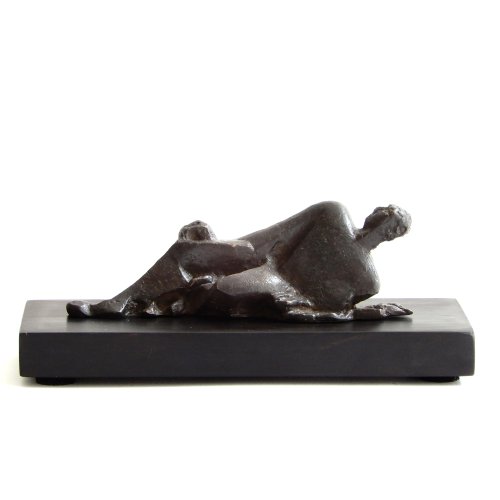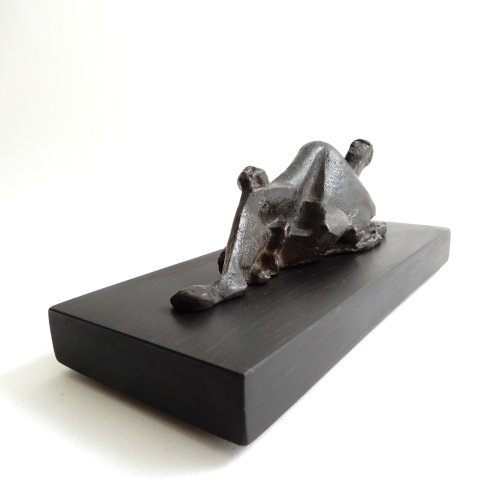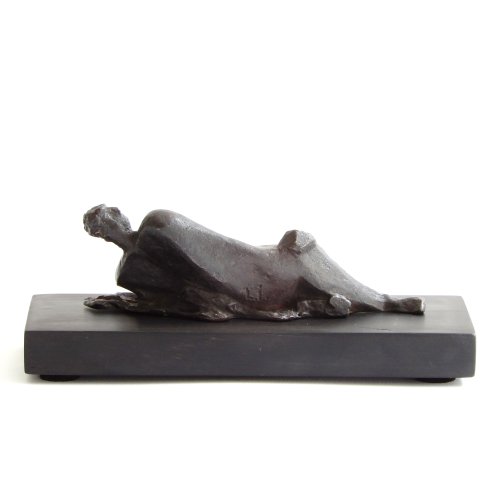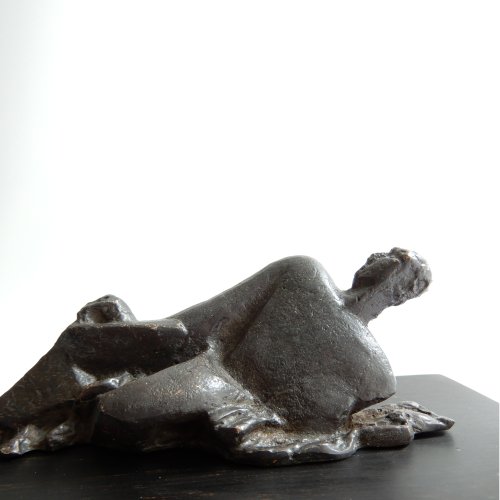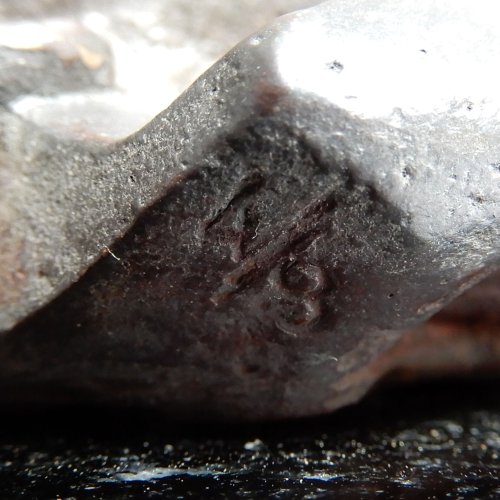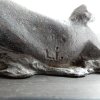Léon Indenbaum (1890-1981) “Petit Homme Cubiste Allongé”
About this piece
This is the smaller version of the reclining Cubist man—a truly special edition, and we are delighted to offer it to you.
When we visit the family, we stay in the guestroom, which also serves as a study. That room features several original pieces by Indenbaum, making staying there an extraordinary experience. Above our bed, there is always a small reclining man, an original bronze piece. I’ve always been a little in love with it and have often asked why a posthumous edition was never created. The answer has always been that casting a small sculpture is relatively expensive. This is true.
To my great surprise, the family recently decided to proceed with it. So far, only two copies have been made. It is indeed costly, so we’ve agreed to set only a small margin to cover our expenses, simply because it’s such a beautiful piece.
Through his work as an assistant to his mentor, the renowned sculptor Emile-Antoine Bourdelle, Indenbaum became accustomed to enlarging small original sculptures into plaster or wax models. Indenbaum also created the reclining Cubist man in a smaller format before later enlarging it in plaster.
This sculpture is signed "L.I." and marked as 4/8. Numbers 1 and 2 were not cast, as they are reserved for the family.
This sculpture also comes with an official certificate signed by Léon Indenbaum's grandson. This sculpture is a first official edition, cast from the original bronze made by Léon Indenbaum in 1932, commissioned by the family. Only a maximum of 12 copies will be cast. The bronze is registered with ADAGP (Society of Authors in the Graphic and Plastic Arts) in Paris.
Biography:
Léon Indenbaum (Tcherikov, now Belarus, 1890 - Opio, 1981) was a Russian-French sculptor associated with the École de Paris artists. His art was innovative, drawing inspiration from the classics, African art, Cubism, and Expressionism.
Indenbaum grew up in the shtetl of Tcherikov with his grandfather, a bookbinder of art books. After elementary school, he trained as a woodworker. Recognizing his talent, the school director arranged for him to attend the Academy of Decorative Arts in Vilnius.
After completing his education there, Indenbaum sought further training and was admitted to the Imperial Academy in Odessa. He studied there for several years until he mistakenly signed up for five years of military service in the Imperial army. With the help of an engineer from Vilnius, he escaped to Paris in March 1911, where he had contacts with an artist friend.
In Paris, he found himself at 'La Ruche' in Montparnasse, an artists' village housed in a round building originally a wine pavilion at the 1900 World Exposition. It was rebuilt by the successful artist Alfred Boucher, who aimed to support poor artists. La Ruche provided studio apartments, each shaped like a slice of cake, with a small kitchen and loft space.
Indenbaum had a studio on the 2nd floor next to Chagall, who, like him, had recently arrived from Russia. Indenbaum lived in La Ruche until 1927, and for a period, he also had a second studio in Montparnasse.
About 200 artists lived in La Ruche, many from Eastern Europe and many were Jewish. Some, like Chaïm Soutine, Ossip Zadkine, Jacques Lipschitz, Chana Orloff, Michael Kikoïne, Moïse Kisling, and Amadeo Modigliani, achieved world fame.
From 1911 to 1919, Indenbaum studied sculpture at the Académie La Grande Chaumière under Antoine Bourdelle, initially as a student and later as his assistant.
In 1912, Indenbaum exhibited at the Paris Salon d'Artistes Indépendants. Despite his poverty, Jacques Doucet, a great art collector and couturier, saw a bust by Indenbaum and commissioned him to create a similar one in onyx. Doucet was pleased and offered Indenbaum a monthly stipend of 1000 francs. In 1914, Indenbaum created the impressive relief 'Musiciens et antilopes' in pink onyx, which sold for 3.3 million euros at Christie's in 2004.
René Poiret, bankers George and Marcel Bénard, and decorator Marcel Coard were regular buyers of Indenbaum's work.
Léon married his muse, Céline Hénin, and they had a daughter, Dinah, in late 1914. His circle of friends included artists like Chaim Soutine, Amadeo Modigliani, Tsuguharu Foujita, Chana Orloff, Michael Kikoïne, and Diego Rivera. Modigliani and Rivera both portrayed Indenbaum in 1913 and 1916. Indenbaum also created portraits of his friends, enjoying the happiest period of his life.
The 1929 stock market crash made life difficult. Many lost their fortunes, and the political climate in France grew hostile toward immigrant artists. The term 'École de Paris' was coined to include these artists but later used derogatorily. Many artists faced anti-Semitism and were banned from exhibiting. Indenbaum, forced to flee Paris during WWII, hid in Seine-et-Marne. He survived, though over 60% of La Ruche's Jewish artists perished in the Holocaust.
After the war, Indenbaum returned to Paris to find his studio looted. He lived reclusively, having separated from Céline and with his daughter in the south of France. Many of his friends had died or, in his view, become too commercial. Refusing to affiliate with galleries, Indenbaum worked in isolation, rejecting even significant commissions.
He co-founded the "Groupe des neuf" in 1963, aiming to honour French post-war figurative sculpture. This group included Jean Carton, Paul Cornet, Raymond Corbin, Marcel Damboise, Léopold Kretz, Raymond Martin, Gunnar Nilsson, Jean Osouf, and Léon Indenbaum. Their exhibitions, including one in 2015/2016 featuring Indenbaum's work, underscored their significance.
In 1968, Indenbaum received the prestigious Prix de sculpture Georges Wildenstein. He spent his later years with his daughter in Opio, passing away at 91, dedicated entirely to his art.
Indenbaum's work is displayed in various museums worldwide and occasionally auctioned at major houses like Christie's, Sotheby's, and MacDougall in London.
Literature and sources:
- Family of Indenbaum
- Jeanine Warnod; "Les artistes de Montparnasse, la Ruche", Éditions Mayer-Van Wilder, Paris 1988. P.42-47, 8, 87,96, 104, 159, 162, 170, 192.
- Nieszawer & Princ; "Histoires des artistes Juifs de l'École de Paris, 1905-1939", Édition Les Étoiles, 2020. P. 190-192, 515 and 516.
- Jeanine Warnod; "l'École de Paris", Édition Musée du Montparnasse, 2012. P. 239, 240 and 243.
- "Chagall, Modigliani, Soutine.... Paris pour école, 1905-1940", Éditions Musée d'Art et d'Histoire du Judaïsme (MAHJ), Paris, 2020 et Réunion des Musée nationaux, Grand Palais, 2020. P. 8, 11, 49, 66, 68, 69, 228, 230, 252.
- G. Annenkoff; "Art Russe Moderne", Éditions Laville, Paris, 1928. P. 50 and 51.
Condition
Excellent
Material:
Bronze, ebbenhout
Measurements:
Length: 13 cm
(5,12")
Year:
Postume casting
Period:
Postume casting
Origin:
France
Artist / atelier:
Léon Indenbaum,
